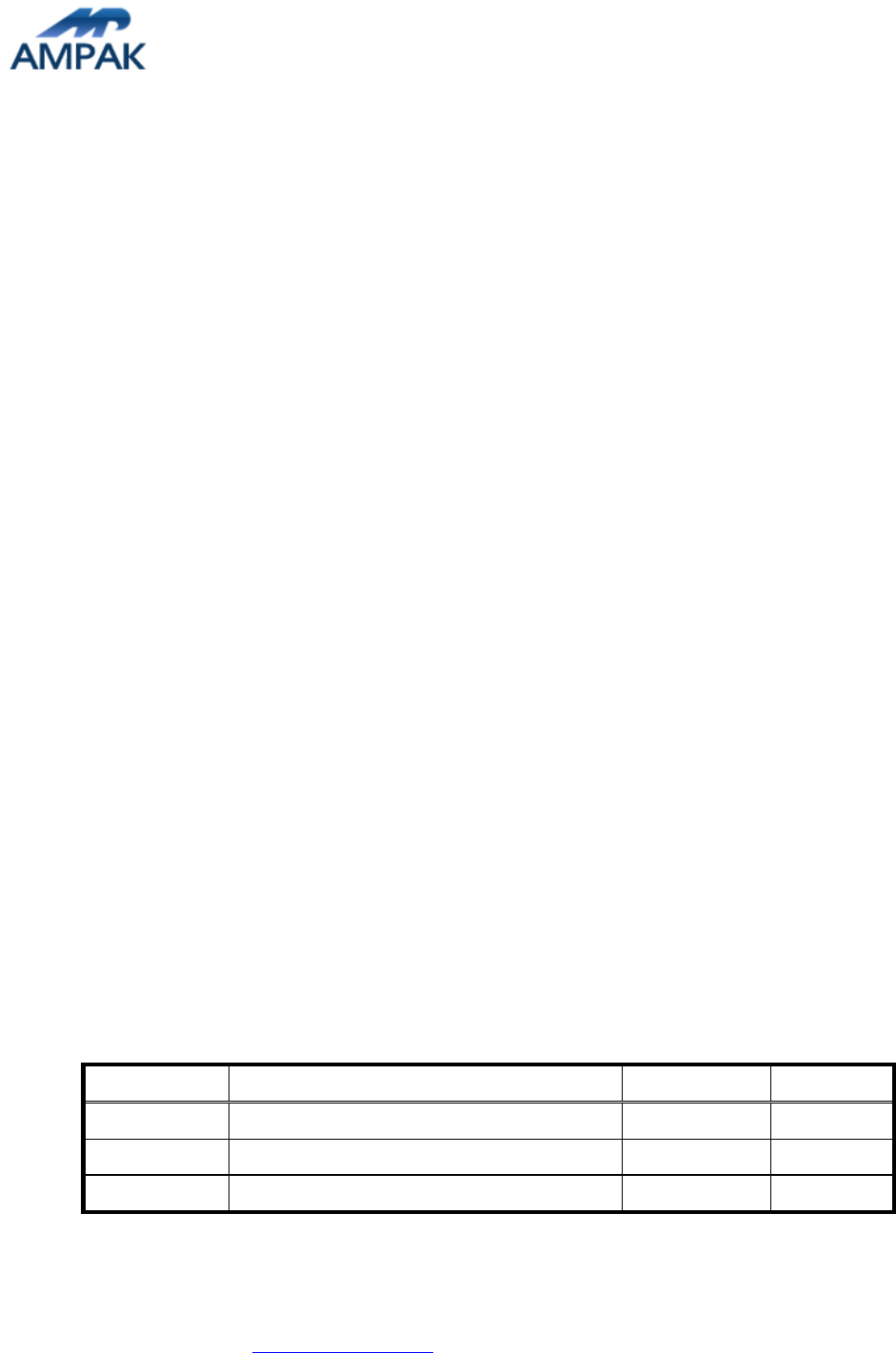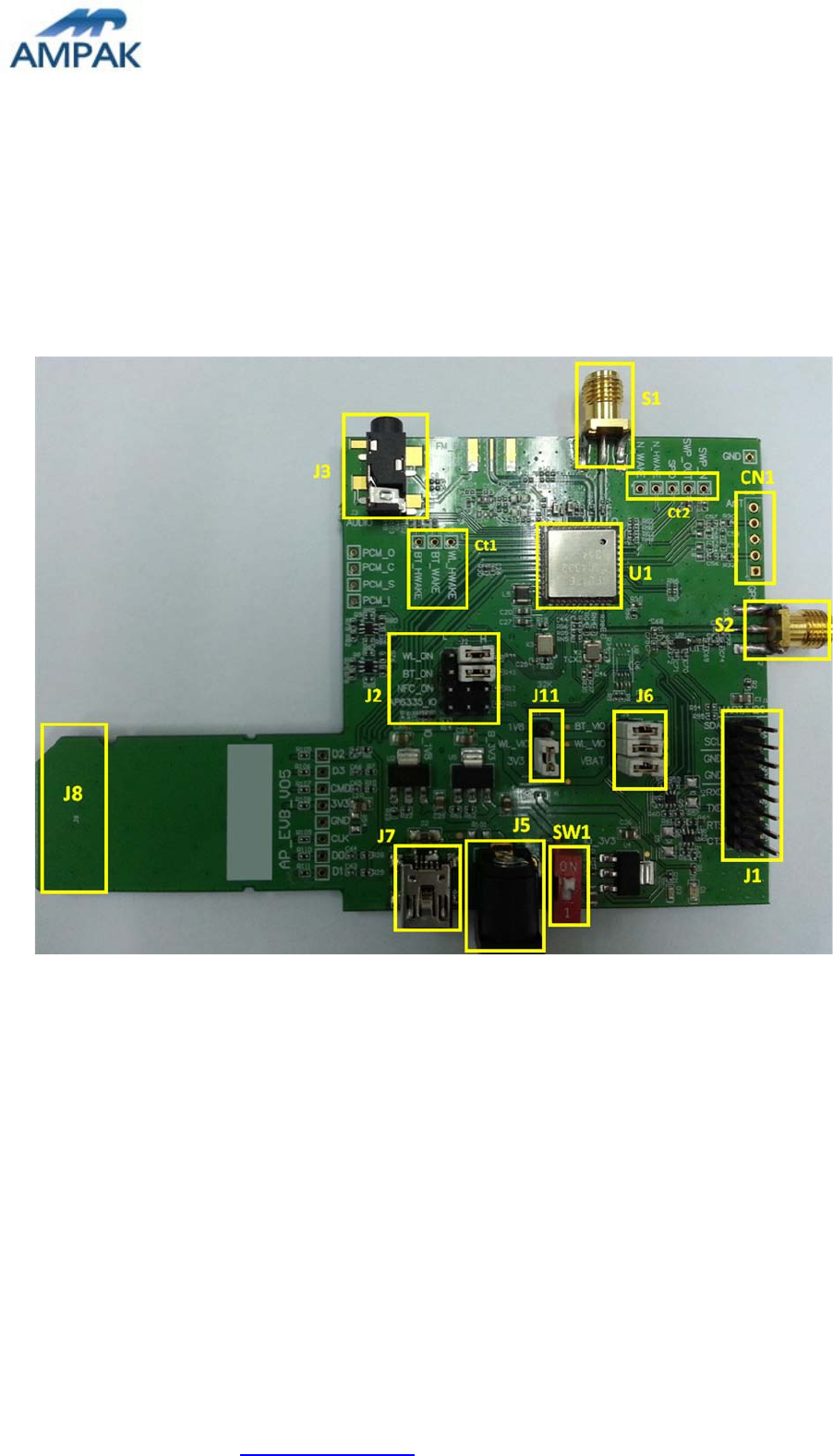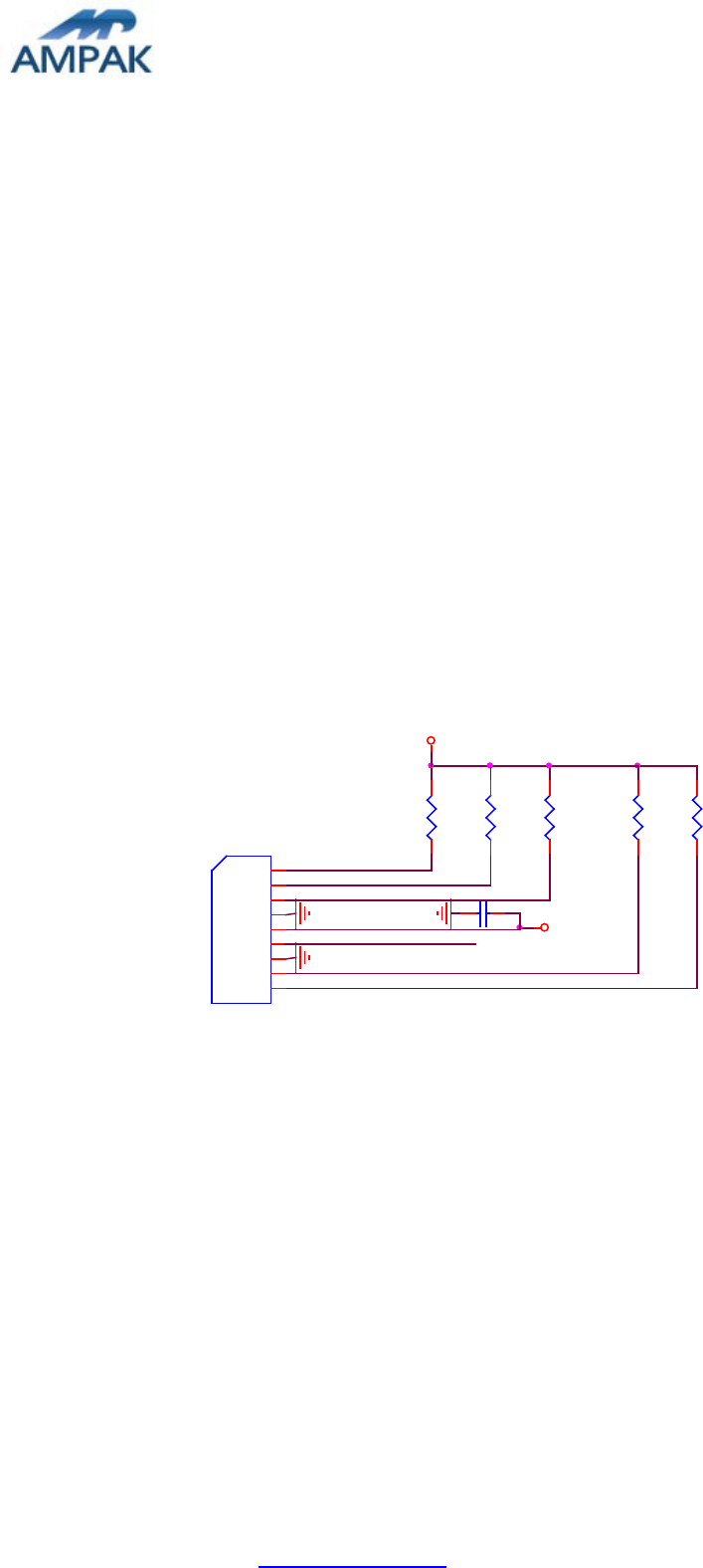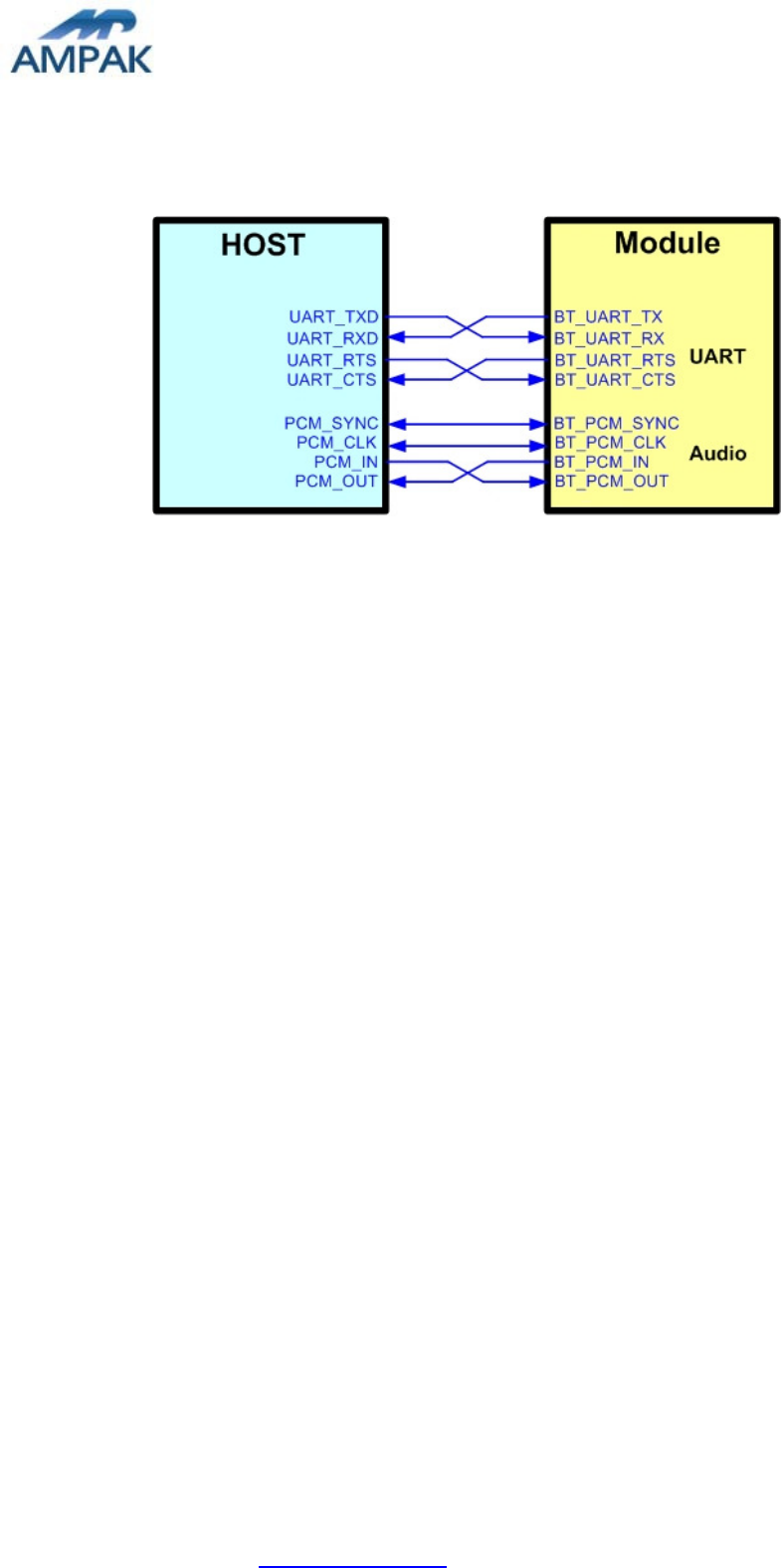AMPAK Technology AP6234A Wifi Dual Band + BT combo module User Manual
AMPAK Technology Inc. Wifi Dual Band + BT combo module
Contents
- 1. User manual
- 2. User Manual.pdf
- 3. User Manual
- 4. Users Manual
User manual

AMPAK Technology Inc. www.ampak.com.tw Proprietary & Confidential Information
i
Doc. NO:
AMPAK
AP6234A series
Evaluation Kits
User manual
Version 1.2
Revision History
Date
Revision Content
Revised By
Version
2012/12/26
Initial released
Dora
1.0
2013/03/07
Modify figure1
Dora
1.1
2013/06/06
Modify figure1
Dora
1.2
2006/8/16 v1.0
Federal Communication Commission Interference Statement
This equipment has been tested and found to comply with the limits for a Class B
digital device, pursuant to Part 15 of the FCC Rules. These limits are designed to
provide reasonable protection against harmful interference in a residential installation.
This equipment generates, uses and can radiate radio frequency energy and, if not
installed and used in accordance with the instructions, may cause harmful
interference to radio communications. However, there is no guarantee that
interference will not occur in a particular installation. If this equipment does cause
harmful interference to radio or television reception, which can be determined by
turning the equipment off and on, the user is encouraged to try to correct the
interference by one of the following measures:
- Reorient or relocate the receiving antenna.
- Increase the separation between the equipment and receiver.
- Connect the equipment into an outlet on a circuit different from that
to which the receiver is connected.
- Consult the dealer or an experienced radio/TV technician for help.
FCC Caution: Any changes or modifications not expressly approved by the party
responsible for compliance could void the user's authority to operate this equipment.
This device complies with Part 15 of the FCC Rules. Operation is subject to the
following two conditions: (1) This device may not cause harmful interference, and (2)
this device must accept any interference received, including interference that may
cause undesired operation.
IMPORTANT NOTE:
FCC Radiation Exposure Statement:
This equipment complies with FCC radiation exposure limits set forth for an
uncontrolled environment. This equipment should be installed and operated with
minimum distance 20cm between the radiator & your body.
This transmitter must not be co-located or operating in conjunction with any other
antenna or transmitter.
Operations in the 5.15-5.25GHz band are restricted to indoor usage only.

2006/8/16 v1.0
This device is intended only for OEM integrators under the following
conditions:
1) The antenna must be installed such that 20 cm is maintained between the
antenna and users, and
2) The transmitter module may not be co-located with any other transmitter or
antenna,
3) For all products market in US, OEM has to limit the operation channels in CH1
to CH11 for 2.4G band by supplied firmware programming tool. OEM shall not
supply any tool or info to the end-user regarding to Regulatory Domain change.
As long as 3 conditions above are met, further transmitter test will not be required.
However, the OEM integrator is still responsible for testing their end-product for any
additional compliance requirements required with this module installed
IMPORTANT NOTE: In the event that these conditions can not be met (for example
certain laptop configurations or co-location with another transmitter), then the FCC
authorization is no longer considered valid and the FCC ID can not be used on the
final product. In these circumstances, the OEM integrator will be responsible for
re-evaluating the end product (including the transmitter) and obtaining a separate
FCC authorization.
End Product Labeling
This transmitter module is authorized only for use in device where the antenna may
be installed such that 20 cm may be maintained between the antenna and users. The
final end product must be labeled in a visible area with the following: “Contains FCC
ID: ZQ6-AP6234A”.
Manual Information To the End User
The OEM integrator has to be aware not to provide information to the end user
regarding how to install or remove this RF module in the user’s manual of the end
product which integrates this module.
The end user manual shall include all required regulatory information/warning as show
in this manual.
2006/8/16 v1.0
Industry Canada statement:
This device complies with Industry Canada licence-exempt RSS standard(s). Operation is
subject to the following two conditions:
(1) this device may not cause interference, and
(2) this device must accept any interference, including interference that may cause
undesired operation of the device.
Le présent appareil est conforme aux CNR d'Industrie Canada applicables aux appareils
radio exempts de licence. L'exploitation est autorisée aux deux conditions suivantes :
(1) l'appareil ne doit pas produire de brouillage, et
(2) l'utilisateur de l'appareil doit accepter tout brouillage radioélectrique subi, même si le
brouillage est susceptible d'en compromettre le fonctionnement.
Radiation Exposure Statement:
This equipment complies with IC radiation exposure limits set forth for an uncontrolled
environment. This equipment should be installed and operated with minimum distance 20cm
between the radiator & your body.
Déclaration d'exposition aux radiations:
Cet équipement est conforme aux limites d'exposition aux rayonnements IC établies pour un
environnement non contrôlé. Cet équipement doit être installé et utilisé avec un minimum de 20 cm
de distance entre la source de rayonnement et votre corps.
2006/8/16 v1.0
This device is intended only for OEM integrators under the following conditions: (For module device
use)
1) The antenna must be installed such that 20 cm is maintained between the antenna and users, and
2) The transmitter module may not be co-located with any other transmitter or antenna.
As long as 2 conditions above are met, further transmitter test will not be required. However, the
OEM integrator is still responsible for testing their end-product for any additional compliance
requirements required with this module installed.
Cet appareil est conçu uniquement pour les intégrateurs OEM dans les conditions suivantes: (Pour
utilisation de dispositif module)
1) L'antenne doit être installée de telle sorte qu'une distance de 20 cm est respectée entre l'antenne
et les utilisateurs, et
2) Le module émetteur peut ne pas être coïmplanté avec un autre émetteur ou antenne.
Tant que les 2 conditions ci-dessus sont remplies, des essais supplémentaires sur l'émetteur ne
seront pas nécessaires. Toutefois, l'intégrateur OEM est toujours responsable des essais sur son
produit final pour toutes exigences de conformité supplémentaires requis pour ce module installé.
2006/8/16 v1.0
IMPORTANT NOTE:
In the event that these conditions can not be met (for example certain laptop configurations or
co-location with another transmitter), then the Canada authorization is no longer considered valid
and the IC ID can not be used on the final product. In these circumstances, the OEM integrator will
be responsible for re-evaluating the end product (including the transmitter) and obtaining a separate
Canada authorization.
NOTE IMPORTANTE:
Dans le cas où ces conditions ne peuvent être satisfaites (par exemple pour certaines configurations
d'ordinateur portable ou de certaines co-localisation avec un autre émetteur), l'autorisation du
Canada n'est plus considéré comme valide et l'ID IC ne peut pas être utilisé sur le produit final.
Dans ces circonstances, l'intégrateur OEM sera chargé de réévaluer le produit final (y compris
l'émetteur) et l'obtention d'une autorisation distincte au Canada.
End Product Labeling
This transmitter module is authorized only for use in device where the antenna may be installed
such that 20 cm may be maintained between the antenna and users. The final end product must be
labeled in a visible area with the following: “Contains IC:
11956A-AP6234A
”.
Plaque signalétique du produit final
Ce module émetteur est autorisé uniquement pour une utilisation dans un dispositif où l'antenne
peut être installée de telle sorte qu'une distance de 20cm peut être maintenue entre l'antenne et les
utilisateurs. Le produit final doit être étiqueté dans un endroit visible avec l'inscription suivante:
"Contient des IC:
11956A-AP6234A
".
Manual Information To the End User
The OEM integrator has to be aware not to provide information to the end user regarding how to
install or remove this RF module in the user’s manual of the end product which integrates this
module.
The end user manual shall include all required regulatory information/warning as show in this
manual.
2006/8/16 v1.0
Manuel d'information à l'utilisateur final
L'intégrateur OEM doit être conscient de ne pas fournir des informations à l'utilisateur final quant à
la façon d'installer ou de supprimer ce module RF dans le manuel de l'utilisateur du produit final qui
intègre ce module.
Le manuel de l'utilisateur final doit inclure toutes les informations réglementaires requises et
avertissements comme indiqué dans ce manuel.
Caution :
(i) the device for operation in the band 5150-5250 MHz is only for indoor use to reduce the
potential for harmful interference to co-channel mobile satellite systems;
(ii) the maximum antenna gain permitted for devices in the bands 5250-5350 MHz and 5470-5725
MHz shall comply with the e.i.r.p. limit; and
(iii) the maximum antenna gain permitted for devices in the band 5725-5825 MHz shall comply
with the e.i.r.p. limits specified for point-to-point and non point-to-point operation as appropriate.
(iv) Users should also be advised that high-power radars are allocated as primary users (i.e. priority
users) of the bands 5250-5350 MHz and 5650-5850 MHz and that these radars could cause
interference and/or damage to LE-LAN devices.
Avertissement:
Le guide d’utilisation des dispositifs pour réseaux locaux doit inclure des instructions précises sur
les restrictions susmentionnées, notamment :
(i) les dispositifs fonctionnant dans la bande 5 150-5 250 MHz sont réservés uniquement pour une
utilisation à l’intérieur afin de réduire les risques de brouillage préjudiciable aux systèmes de
satellites mobiles utilisant les mêmes canaux;
(ii) le gain maximal d’antenne permis pour les dispositifs utilisant les bandes 5 250-5 350 MHz et 5
470-5 725 MHz doit se conformer à la limite de p.i.r.e.;
(iii) le gain maximal d’antenne permis (pour les dispositifs utilisant la bande 5 725-5 825 MHz) doit
se conformer à la limite de p.i.r.e. spécifiée pour l’exploitation point à point et non point à point,
selon le cas.
(iv) De plus, les utilisateurs devraient aussi être avisés que les utilisateurs de radars de haute
puissance sont désignés utilisateurs principaux (c.-à-d., qu’ils ont la priorité) pour les bandes 5
250-5 350 MHz et 5 650-5 850 MHz et que ces radars pourraient causer du brouillage et/ou des
dommages aux dispositifs LAN-EL.

2006/8/16 v1.0
This radio transmitter (IC: 11956A-AP6234A) has been approved by Industry Canada to
operate with the antenna types listed below with the maximum permissible gain and
required antenna impedance for each antenna type indicated. Antenna types not included
in this list, having a gain greater than the maximum gain indicated for that type, are strictly
prohibited for use with this device.
Le présent émetteur radio (IC: 11956A-AP6234A) a été approuvé par Industrie Canada
pour fonctionner avec les types d'antenne énumérés ci-dessous et ayant un gain
admissible maximal et l'impédance requise pour chaque type d'antenne. Les types
d'antenne non inclus dans cette liste, ou dont le gain est supérieur au gain maximal
indiqué, sont strictement interdits pour l'exploitation de l'émetteur.
Type
Manufacture
Gain
Connector
Dipole
Mag.layers
2dBi
SMA Male RP
2006/8/16 v1.0
KCC
해당 무선설비는 전파혼신 가능성이 있으므로 인명안전과 관련된 서비스는 할 수 없음
해당 무선 설비는 5150-5250MHz 대역에서 실내 에서안 사용만 수 있웅.
(Translation: the service related to human safety is not allowed because this device
may have the possibility of the radio interference.)
For RF device using 5150-5250MHz, this device shall be used for indoor only.

802.11b/802.11g/BT 警語
第十二條→經型式認證合格之低率射頻電機,非經許,公司,商或使用者均不得擅自變更頻率大率或
變更原設計之特性及能
第十四條→低率射頻電機之使用不得影響飛航安及擾合法通信經發現有擾現象時,應立即停用,並改善
至無擾時方得繼續使用
前項合法通信,指依電信法規定作業之無線電通信 低率射頻電機須忍合法通信或工業科學及醫療用電波輻
射性電機設備之擾
802.11a 警語
無線傳輸設備 (UNII)
在 5.25-5.35 秭赫頻帶操作之無線資訊傳輸設備,限於室使用 (4.7.5)
無線資訊傳輸設備忍合法通信之擾且不得擾合法通信如造成擾,應立即停用,俟無擾之,始得繼續
使用 (4.7.6)
無線資訊傳設備的製造廠商應確保頻率穩定性,如依製造廠商使用手冊上所述正常操作,發射的信應維持於操作
頻帶中(4.7.7)
模組請註
1. 本模組於得認證後將依規定於模組本體標示審驗合格標籤
2. 系統廠商應於上標示本產品含射頻模組:
CCAFXXLPXXXXTX)字樣

AMPAK Technology Inc. www.ampak.com.tw Proprietary & Confidential Information
Doc. NO:
1
1. AP6XXX Evaluation Board Introduction
AP6XXX Evaluation board (EVB) likes as figure1. That is designed for IEEE802.11
a/b/g/n/ac WLAN with integrated Bluetooth, FM, NFC and GPS application. It is subject
to provide a convenient environment for customer’s verification on WiFi or Bluetooth
function. There are many controller pins and reserved GPIO on Evaluation board which
describes as below.
Figure1. Top view of AP6XXX EVB
Interface highlights:
1. U1: AP6XXX SIP module.
2. J1: UART interface connects with UART transport board for BT and GPS
measuring, it also provides I2C (SDA/SCL) for NFC measuring.
3. J2: Enable(H) or disable(L) Bluetooth, WiFi, NFC function and AP6335_SDIO I/O
voltage selection.(H for SDIO 3.3V, L for SDIO 1.8V)
4. J3: FM audio out interface.
5. J5: 5V DC adaptor input connector.
6. J6: VBAT / WL_VIO / BT_VIO for main system I/O power path.
7. J7: 5V DC mini USB input connector.
8. J8: Standard SDIO interfaces for Wi-Fi performance measured.

AMPAK Technology Inc. www.ampak.com.tw Proprietary & Confidential Information
Doc. NO:
2
9. J11: WL_VIO power path for 1V8 or 3V3 selection.
10. SW1: Power on/off switch.
11. CN1: NFC interface connects with NFC antenna.
12. S1: SMA connector let RF signal in/out path, you could connect with RF cable or
Dipole antenna.
13. S2: SMA connector let GPS RF signal input, you could connect with GPS
antenna.
14. Ct1: WLAN and BT control pins, strongly recommended WL_HWAKE(IRQ)
connected to MCU.
15. Ct2: NFC control pins, strongly recommended N_WAKE and N_H_WAKE
connected to MCU.
2. WiFi function verification step
WIFI SDIO: Using external pull up resistors depends on the SDIO supply voltage. For
1.8V, the resistance range is 30KΩ~82KΩ. For 3.3V, its range from 21
KΩ~41 KΩ on the four data lines and the CMD line as the following circuitry.
SDIO_D3
SDIO_D2
SDIO_D1
C10
10uF
1 2
R6 R7 R10
SDIO_D0
J8
Golden Finger_9
SD3 1
SDCMD 2
GND 3
3.3V 4
SDCLK 5
GND 6
SD0 7
SD1 8
SD2 9
SDIO_CLK
R28 R29
SDIO_CMD
VIO_3V3
SDIO_3V3
Figure2. WiFi verification connection interface to Host SDIO
Hardware Setup:
Refer to Figure2 SDIO pin definition connects the J8 interface of AP6XXX
evaluation board to Host SDIO control interface.
Using pull high resistors (R6, R7, R10, R28, R29) that resistance is 30Kohm for
1.8V or 3.3V VDDIO pull up voltage. (Pull high resistors are un-necessary if at
verification phase.)
Connects an external antenna at SMA connector on the evaluation board.
Note to the VDDIO voltage level should be the same with GPIO voltage level of
Host CPU. (VDDIO 3.3V or 1.8V selection by jump J11)
WiFi software setup:
Please follow up software guideline of Ampak official released.

AMPAK Technology Inc. www.ampak.com.tw Proprietary & Confidential Information
Doc. NO:
3
3. Bluetooth function verification step
Figure3. Bluetooth verification connection interface to Host UART
Hardware Setup:
Refer to Figure3 UART pin definition connects the J1 interface of AP6XXX
evaluation board to Host UART control interface.
Connects an external antenna at SMA connector on the evaluation board.
Note to the VDDIO voltage level should be the same as GPIO voltage level of
Host CPU.
WiFi and Bluetooth software setup:
Please follow up software guideline of Ampak official released.